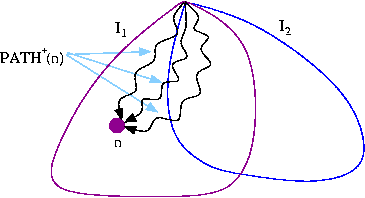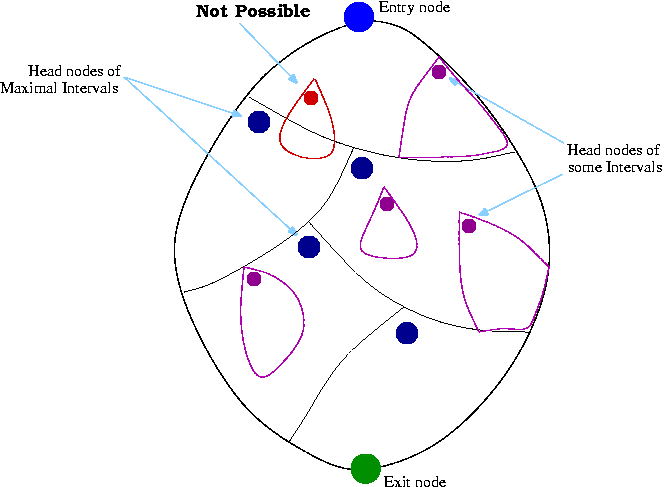- Lemma 1: There is a unique maximal interval for a given head h.
- Lemma 2: The nodes added by the Max_Int algorithm are exactly the nodes that constitute the maximal interval for the given head.
- Proof of Lemma 1
-
Suppose that there is not a unique maximal interval so that there are at least two distinct maximal intervals I1 and I2 with the head h. Clearly, neither I1 nor I2 is a subset of the other. Why? Therefore, there must be at least one node in I1 that is not in I2. Call this node n. Define PATH+(n) to be the set of all nodes on all the paths from h to n. Formally,
PATH+(n) = {x | x ∈ some path from h to n}
We claim that it is possible to extend the interval I2 by adding PATH+(n) to it. In other words, the set,I = I2 ∪ PATH+(n)
is an interval.- There is no path to a node in I from outside I that does not go through h. This is true for all nodes in I2. Any other node included in I came from I1, so there could not be a path to it from outside I1 that does not go through h. Moreover, there cannot be any path to any node in PATH+(n) from I1— PATH+(n) that does not go through h. If there was such a path from a node q in I1 — PATH+(n) to a node r in PATH+(n), then h→+q→+r→*n would be a path from h to n and, by definition, q would be in PATH+(n), a contradiction.
- The set I is connected because all nodes in I are reachable from h.
- The set I — {h} is cycle-free. All nodes belonging to I2 certainly satisfy this property. Since all other nodes in I belong to I1 they must also satisfy this property.
- Proof of Lemma 2
-
Given Lemma 1 it makes sense to talk about the maximal interval for a given head
h. In order to show that the Max_Int algorithm builds the maximal interval we need to prove that
the criteria it uses to add new nodes to expand its set allow the algorithm to pick exactly the nodes in
the maximal interval, i.e., it picks all, and only, the nodes in the maximal interval. We will say that
the nodes that meet the criteria used by the algorithm to augment its set satisfy the pick
condition. Also, we will say that a node that can be added to an existing interval while the
maintaining the interval property of the expanded set satisfies the interval condition. We prove
the lemma by proving that:
pick condition ⇔ interval condition
It is clear that if that is the case then the algorithm will pick exactly the nodes that go into the maximal interval for the head h. We prove the above statement by proving each direction of the arrow.- pick condition ⇒ interval condition
- A node satisfies the pick conditions if it is a successor of any node in the already built set and has all its predecessors within the already built set. Let's call the already built set S, and the node that is selected according to the pick conditions, n. We want to show that given that S is an interval, S ∪ n is an interval (which is exactly the definition of n satisfying the interval condition). This will prove by induction that the algorithm builds a valid interval at every iteration. How? All predecessors of n lie within S. All paths from any node outside S to any node within S go through h, hence all paths to n must also go through h. Since n is a successor of some node in S it is connected to S, implying that S ∪ n is connected. Finally, S ∪ n — {h} cannot contain any cycle, because if it does then there must be a path from n to a node in S — h without involving h, violating the assumption that S is an interval. Thus, the set S — h satisfies all three conditions of an interval and, therefore, is an interval.
- interval condition ⇒ pick condition
- For this direction we want to prove that if a node n satisfies all the conditions to be added to an existing interval then it will be picked by the algorithm. Suppose that S is the interval set that has already been built. Then S ∪ {n} is a valid interval. This means that S ∪ {n} is connected, and therefore at least one predecessor of n must be in S. Moreover, no predecessor of n can be outside S. If there was such a predecessor then there would be a path from a node outside the interval S ∪ {n} to a node inside it (i.e., n) without going through the head h, leading to a contradiction. Thus n satisfies both the pick conditions.
Given the two lemmas, it immediately follows that the algorithm Max_Int builds the unique maximal intervals for a given head node h.
